Back to Don's Maps
 Back to Archaeological Sites
Back to Archaeological Sites
 Back to the review of hominins
Back to the review of hominins
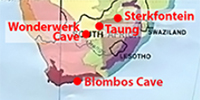 Hominid sites in Africa, including Homo sapiens
Hominid sites in Africa, including Homo sapiens
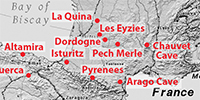 Hominid sites in Europe, including Homo sapiens
Hominid sites in Europe, including Homo sapiens

Rusinga Island, Lake Victoria, Kenya - Panorama taken from the south-eastern direction. It was on this island that Louis Leakey made an especially complete find of Proconsul in 1948.
Photo: Küchenkraut
Permission: Creative Commons Attribution-Share Alike 3.0 Unported license.
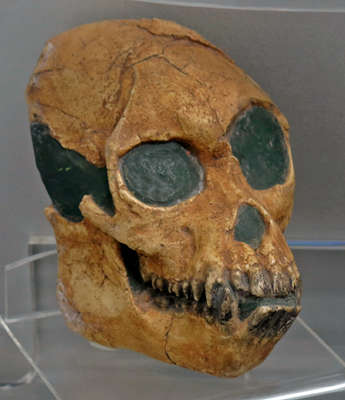
Proconsul africanus
KNM RU 7290
Rusinga Island, Kenya
22 - 17 million years BP
Discovered by M.D. Leakey, 1948
Facsimile
Photo: Don Hitchcock 2013
Source: Western Australian Museum
Proconsul africanus is the first species of the oligocene-era fossil genus of primate to be discovered and was named by Arthur Hopwood, an associate of Louis Leakey, in 1933.Text above from Wikipedia.
The Leakey expedition of 1947 - 1948 to Rusinga Island in Lake Victoria uncovered more species of Proconsul. Mary Leakey made an especially complete find of Proconsul there in 1948, which was for a number of decades labeled africanus, but was reclassified as heseloni in 1993 by Alan Walker.
The 18-million-year-old fossil species has been considered a possible ancestor of both great and lesser apes, and of humans. The palaeontologist Louis Leakey, who was one of the foremost fossil-hunters of the 20th century and a champion of evolution, said:
'An especially important creature was Proconsul africanus. This, many authorities once concluded, gave us an indication of the common stock for apes and men. We have good forelimb bones for it, and in 1948 on Rusinga Island Mary [Leakey] discovered a skull, the first nearly complete specimen ever found. Its canine teeth suggest an ape's, while its forehead reminds us of our own. It seems to me, however, to be neither an ancestral ape, nor yet an ancestor of man, but a side branch with characteristics of both stocks.'
Leakey changed his mind a few times about the exact classification of Proconsul, as did most other palaeontologists. Opinion currently favours a position between the monkeys and the apes.
Note that this Proconsul africanus was first of all reclassified in 1993 as Proconsul heseloni, and then in 2015 as Ekembo heseloni, see McNulty et al. (2015)
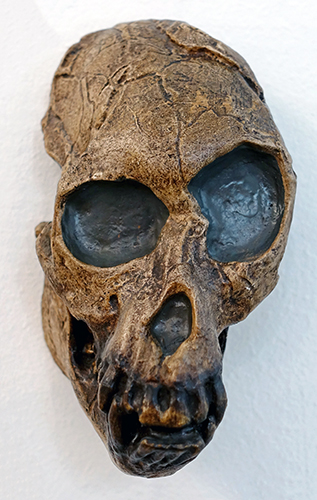
Proconsul africanus
NM RU 7290
Photo: Don Hitchcock 2018
Source: Facsimile, Anthropos Pavilion/Moravian Museum, Brno, Czech Republic
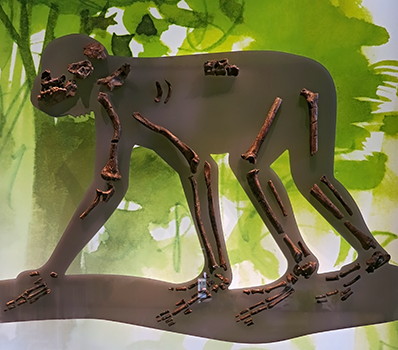
Proconsul bauplan, or body plan.
Proconsul, a tailless quadruped, lived some 18 million years ago in Africa and is one of the best documented Old World monkeys (Catarrhini) of the Miocene: thousands of fossil bone fragments have allowed reconstructions of its body proportions and mode of locomotion.
While its status as a genuine early ape is disputed, Proconsul represents a suitable model for the blueprint of an early hominoid. Here, a montage of the skeleton and a lifelike reconstruction of a young female are shown.
Artist: Unknown
Rephotography: Don Hitchcock 2015
Source and text: Vienna Natural History Museum, Naturhistorisches Museum Wien
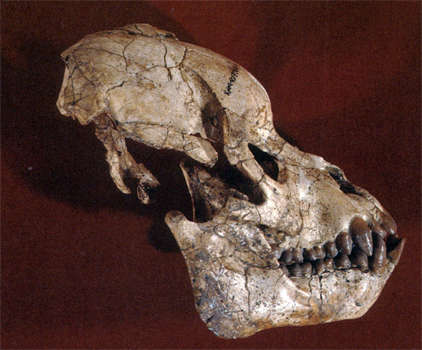
Proconsul africanus
The original Proconsul skull, shown here, was found in 1948. Additional pieces found in museum collections more than 30 years later glued on perfectly.
Right lateral view.
Photo and text: © Alan Walker, Walker and Shipman 2005
(Walker is probably best known for having found the Nariokotome Boy, a 1.7-million-year-old specimen of Homo erectus/ergaster)
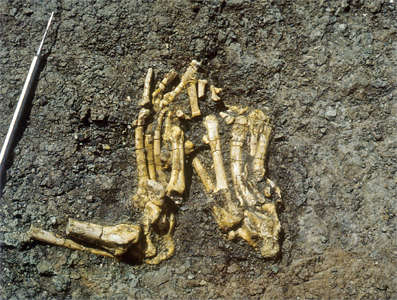
Proconsul africanus
These adult Proconsul feet were still articulated in the rock at Kaswanga Primate Site.
Photo and text: © Mark Teaford, Walker and Shipman 2005
Text below from http://science.psu.edu/news-and-events/2005-news/Walker5-2004.htm
Alan Walker, a distinguished paleontologist, has been intimately associated with Proconsul fossils since his graduate-school days; his wife Pat Shipman, is an anthropologist and celebrated science writer. Together they have crafted a compelling and accessible narrative that educates and fascinates. Both authors are faculty members at Penn State University, where Walker is Distinguished Professor of Anthropology and Biology and Shipman is Adjunct Professor of Anthropology.
In the first part of the twentieth century, fossil teeth, jaws, a spectacular skull of Proconsul found by Mary Leakey, and a stunning partial skeleton shaped anthropologists' ideas of our distant past. In 1980, when Walker happened to recognize some misidentified bones from the well-known partial skeleton in the National Museum of Kenya in Nairobi, the chance find set him on his own quest to unravel Proconsul's secrets.
He began by 'excavating' in the museum, turning up still more pieces of the famous skeleton in the collections. Then he moved on to field work, leading an expedition to remote Rusinga and Mfangano Islands in Lake Victoria, where early finds had been made.
Walker and his field crew struggled against extreme weather, wildlife, and locals who misunderstood their aims, yet they managed to relocate the old Proconsul sites. To their astonishment, they found that the original skeleton site preserved the contents of an ancient hollow tree: skeletons of carnivore's prey that had been carried to its lair. At least one Proconsul , then, was found in a tree. The team also found incredibly rich new sites, returning triumphantly to Nairobi with an unprecedented ten new partial skeletons of Proconsul. As a bonus, they collected hundreds of specimens of contemporary species - rhinos, pigs, carnivores, rodents, hyraxes, reptiles, plants, and trees. They had gathered fossil evidence of almost every aspect of the Miocene community in which Proconsul lived.
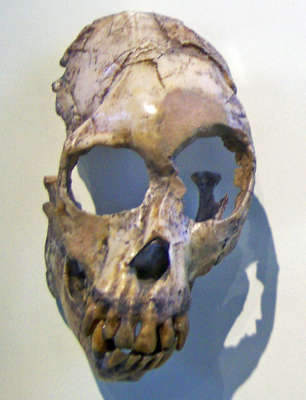
Proconsul africanus
Natural History Museum, London. KNM RU 7920. Age about 18 million years. Rusinga Island, Kenya. The original in Kenya National Museum, Nairobi.
Photo: Nrkpan
Permission: GNU Free Documentation License, Version 1.2
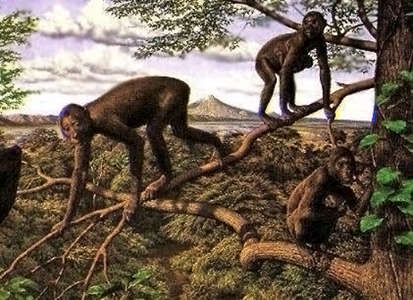
Proconsul africanus
Photo: http://www.liberaong.org/nota_conceptos.php?id=104
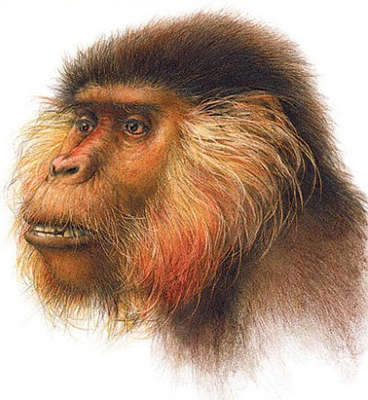
Proconsul africanus
Photo: http://home.hccnet.nl/g.vd.ven/voorouders/plaatjes/gigantopithecus/
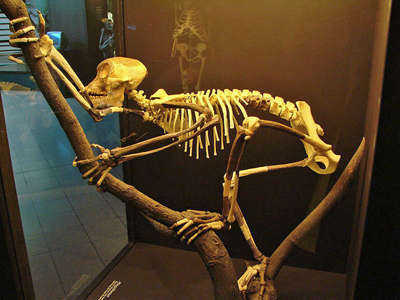
Proconsul africanus
Photo: http://dinosaurs.about.com/od/dinosaurpictures/ig/Prehistoric-Primate-Pictures/Proconsul.htm
Source: University of Zurich
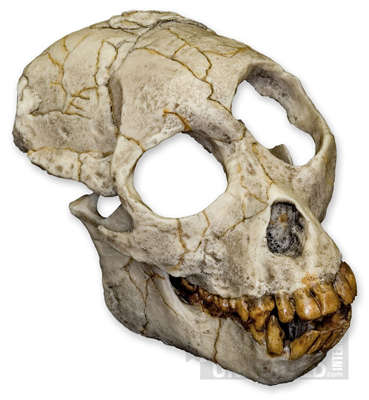
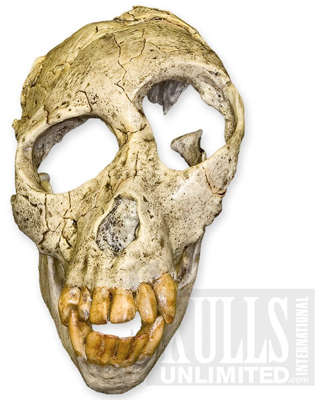
Proconsul africanus
This is a beautifully made and finished facsimile from Skulls Unlimited, who are suppliers of first class specimens of this kind.
They seem to make a special effort to be as accurate as possible, and the results are better than most museums. Note that the original specimen they have made this facsimile from, the almost complete 1948 discovery by Leakey, has been distorted during its time of burial by overlying sediments, as shown in the photo on the right.
Proconsul Skull - Proconsul existed between 14 and 23 million years ago during the Miocene epoch. This species is one of the better represented early Hominid species due to the numerous specimens that have been excavated. This specimen is based on the 1948 Leaky discovery at Victoria Lake, Kenya.
Specifications:
Class: Fossil Hominids
Order: Fossil Hominids
Family: Fossil Hominidae
Origin: Lake Victoria 23 - 14 mya
Diet: Omnivore
Skull Length: 13 cm (5.1 in)
Photo and text: http://www.skullsunlimited.com/record_species.php?id=1814
Hominin timeline.
Note that Homo floresiensis has not been placed on this timeline. van den Bergh et al. (2016) indicate that it may be a form of Homo erectus.
Photo: © National Geographic, Jason Treat, NGM staff
Source: Lee Berger, University of the Witwatersrand (WITS), John Hawks, University of Wisconsin-Madison
Proximate source: http://news.nationalgeographic.com/2017/05/homo-naledi-human-evolution-science/
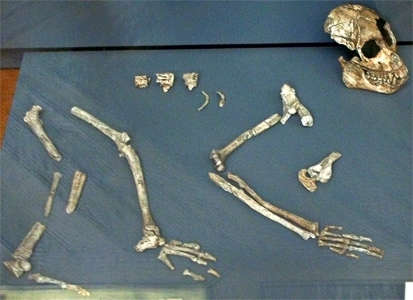
Skeleton of the closely related species, Proconsul nyanzae, now reclassified as Ekembo nyanzae.
Photo: FunkMonk
Permission: Creative Commons Attribution-Share Alike 3.0 Unported license.
Source: Muséum national d'histoire naturelle, Paris.
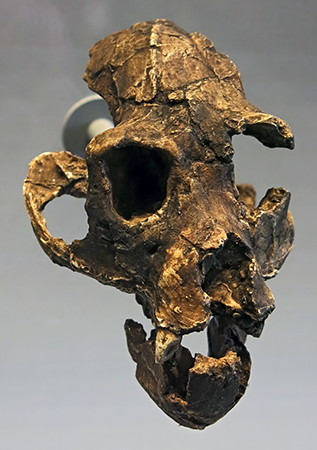

Proconsul heseloni, now reclassified as Ekembo heseloni.
KNM-RU 7290, Rusinga Island, Kenya, circa 18 million years BP.
Photograph: Don Hitchcock 2015
Source and text: facsimile, Vienna Natural History Museum, Naturhistorisches Museum Wien
References
- McNulty K. et al., 2015: A systematic revision of Proconsul with the description of a new genus of early Miocene hominoid, Journal of Human Evolution, 84: 42-61. doi:10.1016/j.jhevol.2015.03.009.
- Walker A., S., Shipman P., 2005: The Ape in the Tree, An Intellectual and Natural History of Proconsul, Harvard University Press, April 2005, 288 Pages; ISBN 0-674-01675-0
- van den Bergh G. et al., 2016: Homo floresiensis-like fossils from the early Middle Pleistocene of Flores, Nature, 534 (7606): 245–248. doi:10.1038/nature17999. PMID 27279221.
